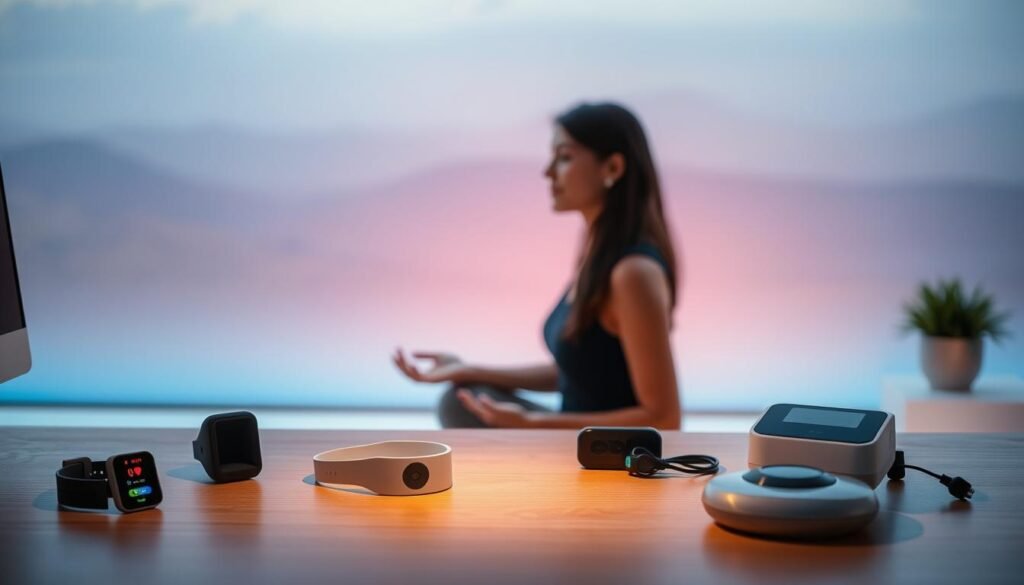Can technology really help calm the mind? Anxiety affects millions worldwide. A new approach is changing how we handle it. Tech-assisted calm is making a big difference, thanks to innovative biofeedback techniques.
Now, people can control their mental health better with biofeedback. This tech gives real-time feedback. It helps people recognize and manage their anxiety.
They can stay calm, even when things get tough. This is a big step forward in managing anxiety.
Key Takeaways
- Biofeedback technology is transforming anxiety management.
- Tech-assisted calm is revolutionizing mental health approaches.
- Real-time feedback enables individuals to regulate their physiological responses.
- Biofeedback helps achieve a state of calm and relaxation.
- Innovative techniques are emerging to combat anxiety.
Understanding Biofeedback and Anxiety
Biofeedback is a helpful tool for managing anxiety. It uses technology to help people find calm. This method tracks and controls body functions like heart rate and blood pressure.
What is Biofeedback?
Biofeedback is a therapy that uses electronic devices to monitor body functions. It helps people understand their body’s responses. This way, they can make changes to feel more relaxed.
Sensors attached to the body track signals like heart rate and skin temperature. This data is shown on a screen. It helps people see how their body reacts to different situations.
How Does Biofeedback Work?
The process starts with sensors on the body. These sensors connect to a device that shows the data in real-time. Then, people do exercises to control their body’s responses.
For example, they might breathe deeply or imagine a calm scene. Their heart rate or skin conductance is monitored. When they change their body’s state, they get feedback. This helps them learn to control their body’s responses.
The Link Between Anxiety and Biofeedback
Anxiety shows up as physical symptoms like a fast heartbeat or sweating. Biofeedback helps people notice these signs. They learn to calm their body’s response, which reduces anxiety.
| Physiological Response | Anxiety Symptom | Biofeedback Technique |
|---|---|---|
| Heart Rate | Rapid Heartbeat | Deep Breathing Exercises |
| Skin Conductance | Sweating | Progressive Muscle Relaxation |
| Muscle Tension | Trembling or Shakiness | Visualization Techniques |
By using biofeedback, people can control their body’s responses better. This reduces anxiety’s impact on their lives. Biofeedback is a powerful tool for calm and better mental health.
The Role of Technology in Biofeedback
Biofeedback technology is key in managing anxiety today. It offers new ways to handle stress. With technology, people can better control their body’s responses.
Types of Biofeedback Devices
There are many types of biofeedback devices. Electrodermal activity (EDA) sensors check the skin’s electrical conductivity, showing stress levels. Electromyography (EMG) sensors look at muscle tension. Heart rate variability (HRV) monitors track the time between heartbeats.
These tools give instant feedback. This helps people understand their body’s state and manage anxiety better.
| Device Type | Measures | Benefits |
|---|---|---|
| EDA Sensors | Skin Conductivity | Indicates Stress Levels |
| EMG Sensors | Muscle Tension | Helps in Relaxation Techniques |
| HRV Monitors | Heart Rate Variability | Assesses Autonomic Nervous System Balance |
Mobile Apps for Anxiety Management
Mobile apps are now big for managing anxiety. Apps like Calm and Headspace offer guided relaxation and meditation. HeartMath provides HRV biofeedback training.
These apps are easy to use, affordable, and accessible. They’re great for those looking to manage anxiety.
Wearable Technology and Stress Monitoring
Wearable tech, like smartwatches and fitness trackers, has improved a lot. They now include biofeedback features for stress tracking. The Apple Watch and Fitbit monitor heart rate and stress.
These devices also offer breathing exercises and relaxation techniques. They help manage stress anytime, anywhere.
Benefits of Biofeedback for Anxiety Relief
Biofeedback is a powerful tool for managing anxiety. It helps people regain control over their mental health. It provides real-time feedback on how the body responds to anxiety.
Reducing Physical Symptoms of Anxiety
Biofeedback can reduce physical symptoms of anxiety. Techniques like heart rate variability and skin conductance biofeedback help monitor and manage stress responses.
A study on heart rate variability biofeedback showed a big drop in anxiety symptoms. Biofeedback training helps recognize and change stress responses, reducing anxiety symptoms.
Improving Emotional Regulation
Biofeedback is key in improving emotional regulation. It helps people understand their emotional states better. This leads to better emotional management.
Biofeedback devices for emotional wellbeing help spot patterns linked to anxiety or stress. Knowing this, people can use techniques like deep breathing to calm their nerves and reduce anxiety.
Boosting Overall Mental Health
Biofeedback also boosts overall mental health. It enhances resilience and promotes relaxation. Regular practice can lead to long-term brain changes, improving stress and anxiety coping.
A comparison of various biofeedback techniques and their benefits is provided in the table below:
| Biofeedback Technique | Primary Benefit | Secondary Benefit |
|---|---|---|
| Heart Rate Variability Biofeedback | Reduces stress and anxiety | Improves cardiovascular health |
| Skin Conductance Biofeedback | Enhances emotional regulation | Helps manage stress responses |
| Electroencephalography (EEG) Biofeedback | Improves cognitive function | Enhances focus and concentration |
By using biofeedback, individuals can experience these benefits. They can enjoy improved overall wellbeing.
How to Get Started with Biofeedback
Biofeedback solutions for mental peace are now easier to find, thanks to new technology. This makes it simpler for people to handle anxiety and boost their mental health.
Choosing the Right Biofeedback Device
There are many biofeedback devices out there, making it hard to choose. Think about what kind of feedback you need, like heart rate or skin conductance. Consulting with a healthcare professional can guide you.
Some well-known biofeedback devices include:
- Wearable sensors that track physiological responses
- Mobile apps that offer guided biofeedback sessions
- Desktop systems for more detailed feedback
Finding a Qualified Practitioner
Finding a skilled practitioner can greatly improve your biofeedback experience. Look for experts with biofeedback therapy certification, like those from the Biofeedback Certification International Alliance (BCIA). They can offer tailored advice and support.
Setting Realistic Goals
Setting realistic goals is key for success in biofeedback. Start by figuring out what you want to achieve, like less anxiety or better sleep. Break down big goals into smaller steps, and keep track of your progress to stay motivated.
“The key to success with biofeedback is consistency and patience. By setting achievable goals and working with a qualified practitioner, individuals can harness the full potential of biofeedback technology.”
By following these steps and using biofeedback for anxiety tech-assisted solutions, you can manage your mental health. This will help you live a more balanced life.
Integrating Biofeedback into Mental Health Treatment
Biofeedback is changing how we treat mental health. It uses technology to help people control their body’s responses. This way, they can better manage their mental health.
Complementing Traditional Therapy
Biofeedback works well with traditional therapies like cognitive-behavioral therapy (CBT). Together, they offer a full treatment plan. This plan tackles both physical and mental anxiety issues.
Key benefits of combining biofeedback with traditional therapy include:
- Enhanced self-awareness through physiological monitoring
- Improved emotional regulation techniques
- A more holistic understanding of the interplay between physical and mental health
Holistic Approaches to Mental Wellness
Holistic mental wellness looks at the whole person, not just the mind. Biofeedback helps manage body responses. This promotes overall well-being.
Some holistic practices that can be combined with biofeedback include:
- Mindfulness meditation
- Yoga and tai chi
- Nutritional counseling
Case Studies: Success Stories
Many case studies show biofeedback’s success in mental health. For example, a study on generalized anxiety disorder found big anxiety symptom drops in those using biofeedback.
These stories show biofeedback’s power in mental health treatment. It offers hope for those seeking relief from anxiety.
Common Misconceptions About Biofeedback
Biofeedback is a technology that helps people relax. But, many people don’t try it because of wrong ideas. It’s important to clear up these myths to show what biofeedback can really do.
Biofeedback is Only for Severe Anxiety
Many think biofeedback is only for those with very bad anxiety. But, biofeedback technology for stress relief helps anyone with stress. It doesn’t matter if your stress is small or big. Biofeedback shows you how your body reacts and helps you control it better.
A study in the Journal of Clinical Psychology showed biofeedback helps with anxiety. It worked for people with mild to moderate anxiety.
It’s Too Complicated to Implement
Some think biofeedback is hard to use. But, many devices and apps are easy to use. Mobile apps for anxiety management have simple guides and interfaces.
Here’s a table showing some popular biofeedback devices. It shows how easy they are to use.
| Device | Ease of Use | Key Features |
|---|---|---|
| Device A | High | Guided sessions, real-time feedback |
| Device B | Medium | Customizable settings, heart rate monitoring |
| Device C | High | Simple interface, portable design |
One-Size-Fits-All Solutions
Some think biofeedback is the same for everyone. But, it’s actually very personal. It’s based on how each person’s body reacts and what they need. Experts make it fit each person’s unique situation.

By fixing these wrong ideas, we can see biofeedback’s real value. As tech tools for calmness get better, biofeedback is a key tool. It offers personal and effective ways to handle anxiety and stress.
Future of Biofeedback Technology
Biofeedback technology is set to change the mental health world with new ideas. It will use advanced tech like artificial intelligence (AI) and machine learning (ML). This will make biofeedback better for managing anxiety.
Innovations on the Horizon
The next biofeedback devices will be smarter, easier to wear, and simpler to use. They will give instant feedback and advice for mental health.
Some of the anticipated innovations include:
- Advanced wearable devices that monitor physiological signals and provide real-time interventions.
- Integration of biofeedback with virtual reality (VR) for immersive therapy experiences.
- AI-driven analysis for more accurate diagnosis and treatment planning.
Potential Research Developments
Research on biofeedback will grow, looking at new mental health issues. This includes depression and post-traumatic stress disorder (PTSD).
Potential research developments may include:
- Investigating the efficacy of biofeedback in diverse populations.
- Exploring the neural mechanisms underlying biofeedback’s effects on mental health.
- Developing standardized protocols for biofeedback therapy.
Predictions for the Mental Health Industry
The mental health field will move towards more tech-based and personalized care. Biofeedback will be key in this change.
“The future of mental health treatment lies in the integration of technology and personalized care. Biofeedback is at the forefront of this revolution.”
The industry will focus on a more complete approach to mental wellness. Biofeedback will be a big part of this.
Tips for Maximizing the Benefits of Biofeedback
Getting the most out of biofeedback is more than just using the device. It’s about being consistent, mindful, and tracking your progress. This approach helps you get the best results.
Consistency is Key
To get the most from biofeedback, use it often. Regular use trains your body to handle stress and anxiety better. It also helps you spot and manage anxiety triggers more easily.
Dr. Joe Dispenza, a well-known neuroscientist, says, “The more you practice, the more your brain learns to respond in new ways.” This shows how important it is to make biofeedback a daily habit.
Combining Biofeedback with Mindfulness
Using biofeedback with mindfulness can make it even more effective. Mindfulness helps you notice your thoughts and body feelings. This makes it easier to understand and use biofeedback data.
- Meditation: Regular meditation improves focus and relaxation, helping with biofeedback training.
- Deep Breathing Exercises: These calm your nervous system, making biofeedback sessions more effective.
- Progressive Muscle Relaxation: This technique increases body awareness, helping with biofeedback data interpretation.
Tracking Progress and Adjusting Techniques
It’s important to track your progress to see how well biofeedback is working. Keeping a journal or using a mobile app to log your sessions can give you valuable insights into your progress.
As
“The greatest wealth is health.” – Virgil
This quote shows why it’s key to monitor and adjust your approach for the best mental health outcomes.

By being consistent, mindful, and tracking your progress, you can get the most out of biofeedback. This leads to better mental peace and emotional wellbeing.
Resources for Further Learning
If you’re interested in learning more about biofeedback for anxiety and tech-assisted calm mental health, there are many resources available. Exploring this topic further can help you understand and use biofeedback techniques better.
Recommended Reading Materials
There are several books and articles that offer insights into biofeedback and its use in managing anxiety. These include works by top researchers in mental health and biofeedback technology.
Online Educational Resources
Online courses and webinars provide interactive learning experiences. They cover everything from the basics of biofeedback to advanced techniques for managing anxiety. These resources are designed to meet different learning needs.
Community Support
Support groups and online communities offer a place for people to share their experiences and learn from others. These communities are a great way to complement your own practice with biofeedback for anxiety relief.



